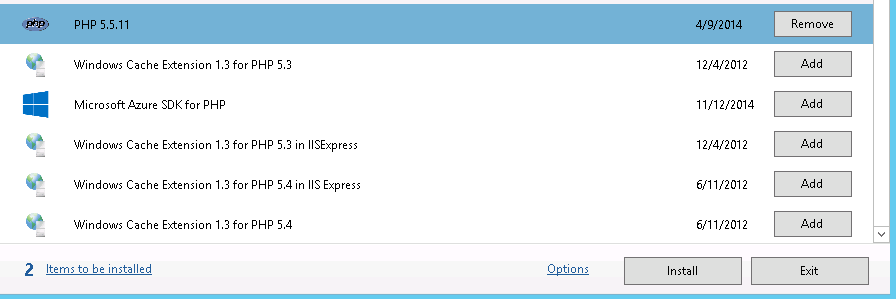A nice InnoDB Corruption Repair Guide
https://forums.cpanel.net/threads/innodb-corruption-repair-guide.418722/
Linux, Windows, Software Tips, Articles and Hacks
A nice InnoDB Corruption Repair Guide
https://forums.cpanel.net/threads/innodb-corruption-repair-guide.418722/
On Windows, similar results can be achieved using the IIS URL Rewrite functionality. To enable this functionality, place the desired rewrite rules in a web.config file in your website’s document root directory. Refer to the IIS documentation for more information.
More info: http://www.iis.net/learn/extensions/url-rewrite-module/using-the-url-rewrite-module
Windows 2008
http://www.microsoft.com/en-us/download/details.aspx?id=7435
For Windows Plesk servers, this KB says that IIS rewrite can be supported in a plesk panel and installed as a panel component – http://kb.odin.com/en/125167
Under Tools and Settings > Updates and upgrades
Click Add/Remove Components
Select IIS URL Rewrite Module and Then Click OK
Once you’ve added a new hard disk to Windows Server 2012, you’ll notice that it’s not showing up as a new drive in My Computer. To add a new hard drive to Windows Server 2012, do the following:
Open Server Manager
Click on File and Storage Services
Click on Disks
Right click on the new hard drive that you’ve just added
Click Bring Online, and click Yes
Next, right click on the new hard drive and click New Volume
Go through the wizard to allocate a drive letter to the new hard disk
# mysqladmin kill process id
In WHM, there are some limits on the resources you can appply at Home » Service Configuration » Apache Configuration » Memory Usage Restrictions.
There is also some information on how to further customize the settingsin the cpanel forums: https://forums.cpanel.net/threads/cpanel-resource-limit.169942/
Edit the /etc/httpd/conf/httpd.conf file.
Change the ‘UserDir disabled’ line to ‘UserDir enabled
Uncomment the ‘UserDir public_html’ line.
Also uncomment the whole ‘
Apply the proper permissions:
# chmod 711 ~<username>
# chmod 755 -R ~<username>/public_html/
<IfModule mod_userdir.c> # # UserDir is disabled by default since it can confirm the presence # of a username on the system (depending on home directory # permissions). # UserDir enabled unixmenuser # # To enable requests to /~user/ to serve the user's public_html # directory, remove the "UserDir disabled" line above, and uncomment # the following line instead: # UserDir public_html </IfModule> <Directory /home/*/public_html> Options Indexes Includes FollowSymLinks ##For apache 2.2,Please use: AllowOverride All Allow from all Order deny,allow #For apache >= 2.4,Please use : Require all granted </Directory>
For the US:
delete from country where country_id <> 223; delete from zone where country_id <> 223;
Server connections speeds are a function of a variety of variables. The server’s connection speed to the Internet, all processes that are simultaneously trying to connect (uploads and downloads share the total speed available), the overall health of the Internet and the connection capability of the off-site computer, which is also limited by the same factors.
Linux
You can test the download speed of a Linux server by downloading a very large file and watching the speed.
# cd /tmp
500 MB
# wget --output-document=/dev/null http://speedtest.wdc01.softlayer.com/downloads/test500.zip
or
# wget --output-document=/dev/null http://cachefly.cachefly.net/100mb.test
Windows
Installing PHP on Windows 2012 with Web Platform Installer
1. Open the Web Platform Installer from the following location on your filesystem:
C:\Program Files\Microsoft\Web Platform Installer\WebPlatformInstaller.exe

Note: If the Web Platform installer is not currently installed it can be downloaded via the following link: https://www.microsoft.com/web/downloads/platform.aspx
Then click the download to open the program.
2. Search for PHP.
3. Select Add next to the version of PHP you wish to install and click Install.

Strict Standards: Non-static method JLoader::register() should not be called statically in /opt/lampp/htdocs/libraries/loader.php on line 71 Strict Standards: Non-static method JLoader::import() should not be called statically in /opt/lampp/htdocs/libraries/joomla/import.php on line 32 Strict Standards: Non-static method JLoader::register() should not be called statically in /opt/lampp/htdocs/libraries/loader.php on line 71
On a cpanel server, edit php.ini:
nano # /usr/local/lib/php.ini ; Print out errors (as a part of the output). For production web sites, ; you're strongly encouraged to turn this feature off, and use error logging ; instead (see below). Keeping display_errors enabled on a production web site ; may reveal security information to end users, such as file paths on your Web ; server, your database schema or other information. display_errors = On
Change to:
; Print out errors (as a part of the output). For production web sites, ; you're strongly encouraged to turn this feature off, and use error logging ; instead (see below). Keeping display_errors enabled on a production web site ; may reveal security information to end users, such as file paths on your Web ; server, your database schema or other information. display_errors = Off
Restart apache:
# service httpd restart